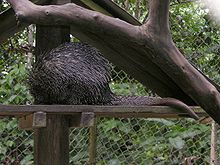Bicolored-spined porcupine: Difference between revisions
Appearance
Content deleted Content added
ShortDescBot (talk | contribs) ShortDescBot adding short description "Species of rodent" |
category for Taxa named by Johann Jakob von Tschudi |
||
| (6 intermediate revisions by 6 users not shown) | |||
| Line 5: | Line 5: | ||
| status = LC |
| status = LC |
||
| status_system = IUCN3.1 |
| status_system = IUCN3.1 |
||
| status_ref = <ref name=iucn>{{cite iucn|author= |
| status_ref = <ref name="iucn status 16 November 2021">{{cite iucn |author=Delgado, C. |date=2016 |title=''Coendou bicolor'' |volume=2016 |page=e.T5083A22214310 |doi=10.2305/IUCN.UK.2016-2.RLTS.T5083A22214310.en |access-date=16 November 2021}}</ref> |
||
| genus =Coendou |
| genus =Coendou |
||
| species = bicolor |
| species = bicolor |
||
| Line 23: | Line 23: | ||
It is found in [[Bolivia]], [[Colombia]], [[Ecuador]], and [[Peru]]. |
It is found in [[Bolivia]], [[Colombia]], [[Ecuador]], and [[Peru]]. |
||
The head and body of ''Coendou bicolor'' measure about 543 mm, and another 481 mm is tail. The body is covered with dense spines, pale yellow at the base and black-tipped, and significantly darker on the midback. The bicolored-spined porcupine has a fully [[prehensile tail]] that is primarily free of spines |
The head and body of ''Coendou bicolor'' measure about 543 mm, and another 481 mm is tail. The body is covered with dense spines, pale yellow at the base and black-tipped, and significantly darker on the midback. The bicolored-spined porcupine has a fully [[prehensile tail]] that is primarily free of spines.<ref>Eisenberg, J. F. (1989). Mammals of the Neotropics, volume 1 - The Northern Neotropics. pp. 391. University of Chicago Press, Chicago IL</ref> |
||
==References== |
==References== |
||
{{Reflist}} |
{{Reflist}} |
||
*Eisenberg, J. F. 1989. Mammals of the Neotropics, volume 1 - The Northern Neotropics. Pp 391. University of Chicago Press, Chicago IL. |
|||
{{Erethizontidae nav}} |
{{Erethizontidae nav}} |
||
| Line 40: | Line 39: | ||
[[Category:Mammals of Peru]] |
[[Category:Mammals of Peru]] |
||
[[Category:Mammals described in 1844]] |
[[Category:Mammals described in 1844]] |
||
[[Category:Taxa named by Johann Jakob von Tschudi]] |
|||
[[Category:Taxonomy articles created by Polbot]] |
[[Category:Taxonomy articles created by Polbot]] |
||
Latest revision as of 02:08, 3 March 2024
| Bicolored-spined porcupine | |
|---|---|

| |
| Scientific classification | |
| Domain: | Eukaryota |
| Kingdom: | Animalia |
| Phylum: | Chordata |
| Class: | Mammalia |
| Order: | Rodentia |
| Family: | Erethizontidae |
| Genus: | Coendou |
| Species: | C. bicolor
|
| Binomial name | |
| Coendou bicolor (Tschudi, 1844)
| |
| Subspecies | |
|
C. b. bicolor Tschudi, 1844 | |

| |
The bicolored-spined porcupine (Coendou bicolor) is a species of nocturnal and arboreal rodent in the family Erethizontidae.[2] It is found in Bolivia, Colombia, Ecuador, and Peru.
The head and body of Coendou bicolor measure about 543 mm, and another 481 mm is tail. The body is covered with dense spines, pale yellow at the base and black-tipped, and significantly darker on the midback. The bicolored-spined porcupine has a fully prehensile tail that is primarily free of spines.[3]
References
[edit]- ^ Delgado, C. (2016). "Coendou bicolor". IUCN Red List of Threatened Species. 2016: e.T5083A22214310. doi:10.2305/IUCN.UK.2016-2.RLTS.T5083A22214310.en. Retrieved 16 November 2021.
- ^ Woods, C.A.; Kilpatrick, C.W. (2005). "Infraorder Hystricognathi". In Wilson, D.E.; Reeder, D.M (eds.). Mammal Species of the World: A Taxonomic and Geographic Reference (3rd ed.). Johns Hopkins University Press. pp. 1538–1600. ISBN 978-0-8018-8221-0. OCLC 62265494.
- ^ Eisenberg, J. F. (1989). Mammals of the Neotropics, volume 1 - The Northern Neotropics. pp. 391. University of Chicago Press, Chicago IL

